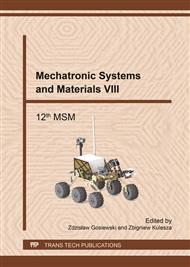[1]
C. Fischer, Preparatory Study to establish the Ecodesign Working Plan implementing Directive Draft Task 1 Report Document information Or, no. October 2014, p.1–48, (2015).
Google Scholar
[2]
T. Behrendt, A. Zein, and S. Min, Development of an energy consumption monitoring procedure for machine tools, CIRP Ann. - Manuf. Technol., vol. 61, p.43–46, (2012).
DOI: 10.1016/j.cirp.2012.03.103
Google Scholar
[3]
M. Mori, M. Fujishima, Y. Inamasu, and Y. Oda, A study on energy efficiency improvement for machine tools, CIRP Ann. - Manuf. Technol., vol. 60, p.145–148, (2011).
DOI: 10.1016/j.cirp.2011.03.099
Google Scholar
[4]
R. Neugebauer, M. Wabner, H. Rentzsch, and S. Ihlenfeldt, Structure principles of energy efficient machine tools, CIRP J. Manuf. Sci. Technol., vol. 4, no. 2, p.136–147, (2011).
DOI: 10.1016/j.cirpj.2011.06.017
Google Scholar
[5]
J. Augste, M. Holub, and R. Knoflicek, Tools for Visualization of Active Power and Energy at Machine Tools., Mechatron. Syst. Mater. Opole, Pol. Oficyna Wydaw. Politech. Opol. 2014. s. 1-5. ISBN 978-83-64056-58- 1.
Google Scholar
[6]
J. Augste, M. Holub, R. Knoflicek, T. Novotný, and J. Vyroubal, Monitoring of Energy Flows in the Production Machines., Mechatronics 2013 Recent Technol. Sci. Adv. 1. Springer Int. Publ. Switz. Spinger, 2013. s. 1.
DOI: 10.1007/978-3-319-02294-9_1
Google Scholar
[7]
P. Blecha, R. Huzlík, P. Houška, and M. Holub, Device for electric power measurement at machine tools., MM Scinece Journal, 2012, roč. 2012, č. Spec. issue, s. 1-6. ISSN 1805- 0476.
Google Scholar
[8]
J. Augste, R. Knoflicek, M. Holub, and T. Novotný, T. TOOLS FOR VISUALIZATION OF ENERGY FLOWS IN THE CONSTRUCTION OF MACHINE- TOOLS., MM Sci. Journal, 2013, roč. 2013, č. March, s. 392-395. ISSN 1803- 1269.
DOI: 10.17973/mmsj.2013_03_201303
Google Scholar
[9]
I. Garciaherreros, X. Kestelyn, J. Gomand, and P. -J. Barre, Decoupling basis control of dual-drive gantry stages for path-tracking applications, 2010 IEEE Int. Symp. Ind. Electron., p.131–136, Jul. (2010).
DOI: 10.1109/isie.2010.5637612
Google Scholar
[10]
I. García-Herreros, X. Kestelyn, J. Gomand, R. Coleman, and P. J. Barre, Model-based decoupling control method for dual-drive gantry stages: A case study with experimental validations, Control Eng. Pract., vol. 21, p.298–307, (2013).
DOI: 10.1016/j.conengprac.2012.10.010
Google Scholar
[11]
Y. Halevi, E. Carpanzano, G. Montalbano, and Y. Koren, Minimum energy control of redundant actuation machine tools, CIRP Ann. - Manuf. Technol., vol. 60, p.433–436, (2011).
DOI: 10.1016/j.cirp.2011.03.032
Google Scholar
[12]
J. M. Pavel Souček, Obráběcí stroje a technologie na EMO Milano 2009.
Google Scholar
[13]
D. J. Gordon and K. Erkorkmaz, Precision control of a T-type gantry using sensor/actuator averaging and active vibration damping, Precis. Eng., vol. 36, no. 2, p.299–314, (2012).
DOI: 10.1016/j.precisioneng.2011.11.003
Google Scholar
[14]
T. S. Giam, K. K. Tan, and S. Huang, Precision coordinated control of multi-axis gantry stages, ISA Trans., vol. 46, p.399–409, (2007).
DOI: 10.1016/j.isatra.2007.02.002
Google Scholar
[15]
M. -F. Hsieh, H. -Y. Li, and K. -Y. Lai, Synchronous control of a network-based triple mechanically-coupled ball screws system, SICE Annu. Conf. 2011, no. dll, p.1081–1086, (2011).
Google Scholar
[16]
M. F. Hsieh, W. S. Yao, and C. R. Chiang, Modeling and synchronous control of a single-axis stage driven by dual mechanically-coupled parallel ball screws, Int. J. Adv. Manuf. Technol., vol. 34, p.933–943, (2007).
DOI: 10.1007/s00170-007-1135-4
Google Scholar
[17]
Z. Q. Luo and D. L. Liang, Mathematical Model and Characteristics Analysis of the Novel Dual-Redundancy Permanent Magnet Brushless Machine System, Appl. Mech. Mater., vol. 416–417, p.418–427, (2013).
DOI: 10.4028/www.scientific.net/amm.416-417.418
Google Scholar
[18]
L. Zhao, X. Zhang, and J. Ji, a Torque Control Strategy of Brushless Direct Current Motor With Current, Int. Converence Mechatronics Autom., p.303–307, (2015).
DOI: 10.1109/icma.2015.7237501
Google Scholar
[19]
J. Toman, V. Singule, and Z. Hadaš, Model of aircraft actuator with BLAC motor, 16th Int. Power Electron. Motion Control Conf. Expo. PEMC 2014, p.197–202, (2014).
DOI: 10.1109/epepemc.2014.6980712
Google Scholar
[20]
J. F. Gieras, Z. J. Piech, and B. Z. Tomczuk, Topologies and Section, Linear Synchronous Mot. Transp. Autom. Syst., p.1–33, (2011).
Google Scholar
[21]
Maxon, Maxon Motor RE 36 Datasheet., [Online]. Available: http: /www. treffer. com. br/produtos/maxon/motores/pdf/84. pdf.
Google Scholar
[22]
Maxon, Maxon Motor RE 40 Datasheet., [Online]. Available: http: /www. treffer. com. br/produtos/maxon/motores/pdf/83. pdf.
Google Scholar
[23]
J. H. Seo, T. K. Chung, C. G. Lee, S. Y. Jung, and H. K. Jung, Harmonic iron loss analysis of electrical machines for high-speed operation considering driving condition, IEEE Trans. Magn., vol. 45, no. 10, p.4656–4659, (2009).
DOI: 10.1109/tmag.2009.2022316
Google Scholar
[24]
P. a. Hargreaves, B. C. Mecrow, and R. Hall, Calculation of iron loss in electrical generators using finite element analysis, 2011 IEEE Int. Electr. Mach. Drives Conf., vol. 48, no. 5, p.1368–1373, (2011).
DOI: 10.1109/iemdc.2011.5994805
Google Scholar
[25]
D. M. Ionel, M. Popescu, M. I. McGilp, T. J. E. Miller, S. J. Dellinger, and R. J. Heideman, Computation of core losses in electrical machines using improved models for laminated steel, IEEE Trans. Ind. Appl., vol. 43, no. 6, p.1554–1564, (2007).
DOI: 10.1109/tia.2007.908159
Google Scholar
[26]
R. Huzlík, M. Holub, F. Bradáč, and P. Blecha, Simulation of Linear Axis with Ball Screw and Permanent Magnet Synchronous Machine, in MM Science Journal, 2012, roč. 2012, č. Special Issue, s. 1-4. ISSN: 1803- 1269.
Google Scholar


